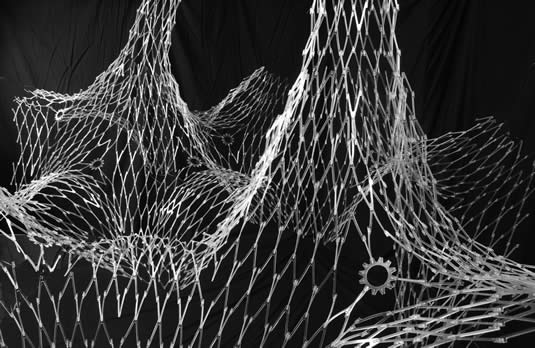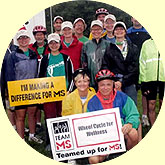- UW profs explore the technology of design
- Research priorities for higher education
- Wheeling for MS wellness
- Editor:
- Chris Redmond
- Communications and Public Affairs
- bulletin@uwaterloo.ca
We were disconnected
The problem with internet on campus, an inability to connect with off-campus sites, was an external service provider problem, says IST’s Network Services. The disconnect lasted from 10 p.m. Thursday to 4 p.m. today.
Link of the day
When and where
ES2 patio off hallway 290 is being rebuilt; access doors will be locked August 16 – 28.
Services off in CEIT: heating, ventilation, A/C, equipment cooling loop, fumehood exhaust, Saturday, 7 – 9 a.m. Computer users are advised to shut down, especially UNIX systems: contact CHIP for help.
Services off in PAS: heating, ventilation, A/C, Saturday, 8 a.m. to 8 p.m.
Tour the UW Weather Station on Saturday starting 10 a.m., rain or shine. To register, email weather@civmail.uwaterloo.ca
UW Warrior Hockey Camps for children 5 - 13 next week, Monday to Friday.
Hot water and steam will be off for all buildings within the Ring Road and Village I, from Tuesday, August 21, 12:01 a.m. to Wednesday, August 22, 4 p.m.
Fall term tuition fees due August 27 if paid by cheque, September 5 by bank payment. Fee statements will be available to students through Quest this week.
PhD oral defences
Planning. Wendy Janine McWilliam, “Edge Effects Within Municipal Forests: Are Municipal Policies Effective in Limiting Edge-Resident Encroachment in Suburban Woodlands?” Supervisors, Mark Seasons, Paul Eagles. On display in the faculty of environmental studies, ES1 room 335. Oral defence Monday, August 27, 9:30 a.m., ES1 room 221.
Geography. Sonya Rita Graci, “Accommodating Green: Examining the Factors that Influence Environmental Commitment in the Tourist Accommodation Industry.” Supervisors, G. Wall, M. Haight. On display in the faculty of environmental studies, ES1 room 335. Oral defence Monday, September 10, 1:00 p.m., ES1 room 221.
Biology. Zhong Sun, “Characterization of the Pro-apoptotic Function of eIF5A in Human Cancer Cell Lines.” Supervisor, J.E. Thompson. On display in the faculty of science, ESC room 254A. Oral defence Tuesday, September 11, 1:30 p.m., PHY room 352.
Biology. Michael A. Sokal, “Assessment of Hydroecological Changes at the Slave River Delta, NWT, Using Diatoms in Seasonal, Inter-Annual and Paleolimnological Experiments.” Supervisors, R.I. Hall, B.B. Wolfe. On display in the faculty of science, ESC room 254A. Oral defence Wednesday, September 12, 10:00 a.m., C2 room 361.
Electrical and computer engineering. Wei Song, “Resource Allocation for Cellular/WLAN Integrated Networks.” Supervisor, Weihua Zhuang. On display in the faculty of engineering, PHY 3004. Oral defence Friday, September 14, 9:30 a.m., EIT room 3142.
Chemical engineering. Peter Chladek, “Catalytic Separation of Pure Hydrogen from Synthesis Gas.” Supervisors, Eric Croiset, Robert Hudgins. On display in the faculty of engineering, PHY 3004. Oral defence Monday, September 17, 9:30 a.m., DWE room 2534.
Electrical and computer engineering. Lei Chen, “A New Design of Multiple Classifier System and its Application to Classification of Time Series Data.” Supervisor, Mohamed Kamel. On display in the faculty of engineering, PHY 3004. Oral defence Monday, September 17, 2 p.m., Davis Centre room 1331.
Mechanical and mechatronics engineering. Dennis Tiriff, “A Study in the Process Kinetics of TLP Sintering in a Binary-Isomorphous Alloy System.” Supervisor, Steve Corbin. On display in the faculty of engineering, PHY 3004. Oral defence Wednesday, September 19, 1:30 p.m., E2X room 4117.
Chemical engineering. Hyung Sang Park, “Surface Tension Measurement of Polystyrenes in Supercritical Fluids.” Supervisors, Pu Chen, Costas Tzoganakis, Chul B. Park. On display in the faculty of engineering, PHY 3004. Oral defence Thursday, September 20, 2:00 p.m., DWE room 2534.
UW professors explore the technology of design
 Two UW architecture professors, Thomas Seebohm and Philip Beesley, are highlighted in the June 2007 issue of Canadian Architect magazine, a special issue on “the New World of Design” that “explores some of the many ideas emerging from the Canadian Design Research Network.”
Two UW architecture professors, Thomas Seebohm and Philip Beesley, are highlighted in the June 2007 issue of Canadian Architect magazine, a special issue on “the New World of Design” that “explores some of the many ideas emerging from the Canadian Design Research Network.”
CDRN is a federal network of centres of excellence. Its more than 100 researchers include seven professors from UW’s School of Architecture: Beesley, who also leads the CDRN’s fabrication theme area, Seebohm, Terri Meyer Boake, Eric Haldenby, Derek Revington, Val Rynnimeri, and John Straube; and one each from electrical and computer engineering (Rob Gorbet), planning (Brent Hall), computer science (Michael McCool), and systems design engineering (John Zelek).
An article in the June issue by Ian Chodikoff, “Digital Fabrication: the Machinery,” looks at some of the new design hardware. It begins: “Architect and University of Waterloo architecture professor Philip Beesley provides a few pointers for firms who are interested in purchasing digital fabrication equipment. Beesley, who looks at digital fabrication as an automated construction and design approach, explains that the cost of investing in 3D printers has dropped significantly over the past few years.”
The article goes on to describe the types of digital fabrication machines, how they operate, and how they are being used to create architectural models and building prototypes. The photo at the top of this page, Beesley told the Daily Bulletin, shows “a prototype building canopy, using a diagrid meshwork structural system composed of lightweight polymer snap-fit elements, manufactured at Waterloo architecture's digital fabrication laboratory.” He is developing “extremely lightweight, flexible systems that could be used for future buildings. The image shown is part of a large installation opening at the Montreal Museum of Fine Arts this September.”
In the same issue, Thomas Seebohm co-authors an essay on “The Changing Face of Practice.” He suggests that collaboration, often by researchers in different cities or provinces, is increasingly the wellspring of creative design. As one example he mentions “new software tools for participatory visualization and urban and landscape design ... developed in a collaboration between the School of Computer Science at the University of Waterloo and Parallel World Labs of Toronto.”
The UW people involved were Michael McCool and Kevin Moule. Moule is now a PhD student, but while working on this software, called OrbisRT, he was systems manager and graphics programmer for the Integrated Centre for Visualization, Design and Manufacturing, a state-of-the-art design research lab installed in the Davis Centre in 2002. Seebohm was the centre’s founding director; Beesley is the current co-director. Researchers from faculties across UW and from other universities used the lab to work in virtual three-dimensional space, simulating anything from the manufacture of machine parts to interior lighting schemes to the layout of cities. “OrbisRT is therefore one of the successful outcomes of the ICVDM,” Seebohm told the Daily Bulletin. “The centre will be terminated in October,” he adds, “since we have achieved our objectives.”
Research priorities for higher education
An announcement from the Higher Education Quality Council of Ontario
While there have been noticeable signs of progress within Ontario’s postsecondary education system, some key questions related to the overall quality of the system remain unanswered, according to the Higher Education Quality Council of Ontario.
The new arm's-length agency of the provincial government has released its first Review and Research Plan, a multi-year strategy that assesses the existing body of research on higher education in Ontario, identifies information gaps and sets out the council’s long-term research priorities under the themes of access, learning quality, accountability and inter-institutional cooperation.
“70 per cent of all new jobs in Ontario are expected to require education above a high school diploma and all indicators show that number will continue to rise,” said the council’s chair, Frank Iacobucci. “But it is not just our jobs that are becoming more complex; so too are the requirements of citizenship. It is essential then that we understand how a good system of higher education might be made even better, in order to meet the social and economic challenges of Ontarians.”
Some of the council’s research priorities outlined in the plan include: studying the full range of factors that influence students’ choice to attend higher education; examining ways to identify and promote best practices in teaching and student services; and understanding the factors that have supported the development of successful joint college-university collaboration.
“We need to know if the quality of teaching and learning is improving, if students are mastering the skills they require to succeed, and how Ontario compares with the quality of higher education across Canada and around the world,” explained council president James Downey, former president of UW. “With the Review and Research Plan, the council has taken an important first step to identify the ways we can build on established research and work with the entire sector to help answer these important questions and support the ongoing improvement of higher education in Ontario.”
“Compared to those with only a high school diploma, postsecondary graduates earn more money over their lifetimes, experience fewer and shorter periods of unemployment and are more likely to participate in the community as citizens and volunteers,” said the council’s vice-president for research, Ken Norrie. “Ensuring the quality of higher education in Ontario will support the continued success and well-being of Ontarians.”
The full report from HEQCO is available online as a pdf file.
Wheeling for MS wellness
Six hundred bicycles? That’s how many the Rona MS Bike Tour could bring to campus this weekend. The bike tour is an annual event held to raise funds for research towards a cure for multiple sclerosis, and to help people afflicted with the disease.  The tour is divided into geographical sections crossing southern Ontario. The Brampton to Waterloo section covers 190 kilometres; up to 600 participants, and their bikes, will stay in UW’s student residences overnight, August 18 to 19.
The tour is divided into geographical sections crossing southern Ontario. The Brampton to Waterloo section covers 190 kilometres; up to 600 participants, and their bikes, will stay in UW’s student residences overnight, August 18 to 19.
There’s another UW connection to the MS bike tour: “WheelCycle for Wellness” is a team made up of Stratford and Waterloo people (left), many of them UW staff or faculty. They will be heading out on the Niagara division of the tour on August 26. Interested in joining the group for next year? Email lmackay@uwaterloo.ca.
CPA staff

